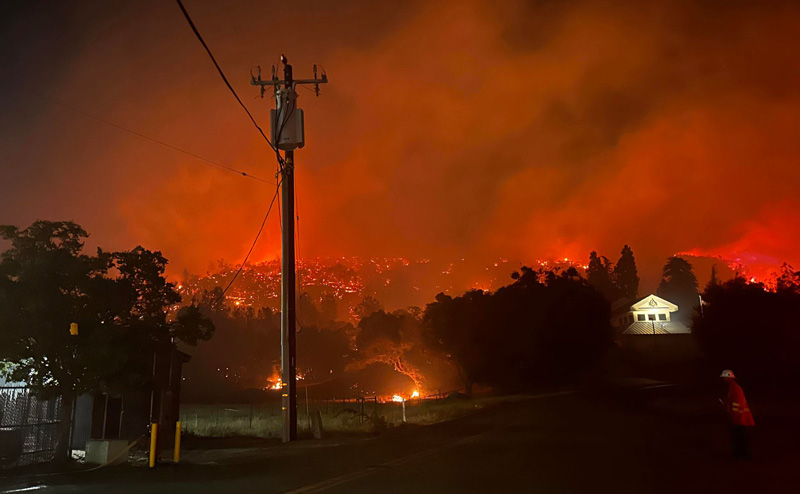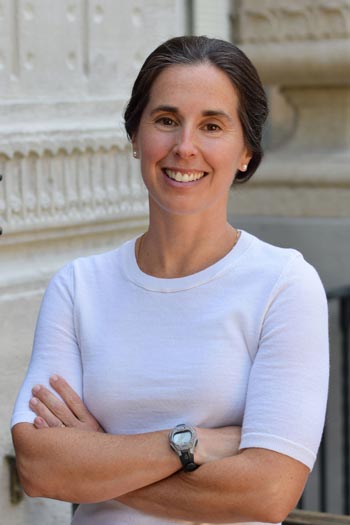
Mariposa County French Fire on July 4, 2024 - Photo taken looking towards the Mariposa Masonic Lodge. Credit: Sierra Sun Times
As lawmakers scramble to reform homeowners’ insurance regulations, a new study examines how insurers are pricing wildfire risk — and how different strategies can significantly impact premiums.
July 22, 2024 - By Kara Manke - Homeowners across the country are scrambling to keep up with the rising price of property insurance — and for people living in disaster-prone areas, the options for insuring their property are dwindling. Many insurers are raising premiums significantly or leaving high-risk markets altogether.
While climate change is a contributing factor, data suggest that higher rates are not always correlated with higher risks of climate-related disasters, like wildfires and hurricanes. In California, lawmakers are scrambling to reform regulations that were not designed with the pressures of climate change in mind.
“All of a sudden, regulators are finding themselves on the front lines of climate change, and that creates real challenges in rethinking how we’re regulating these property insurance markets,” said Meredith Fowlie, a professor of agricultural and resource economics at UC Berkeley.
Fowlie is co-author of a new study that takes a deep dive into the relationship between wildfire risk and insurance prices in California. Berkeley News spoke with Fowlie about the findings, which reveal how an economics phenomenon called the “winner’s curse” is an under-appreciated factor behind rising insurance premiums, and what this may mean for insurance regulators and consumers in the state.
The study was published as a National Bureau of Economic Research working paper and is co-authored by Judson Boomhower of UC San Diego, Jacob Gellman of the University of Alaska Anchorage and Andrew J. Plantinga of UC Santa Barbara.
Berkeley News: Could you describe the homeowners insurance crisis in California?
 Meredith Fowlie is a professor in the Department of Agricultural and Resource Economics at UC Berkeley.
Meredith Fowlie is a professor in the Department of Agricultural and Resource Economics at UC Berkeley.Meredith Fowlie: The main things we’re seeing are reduced affordability and availability of homeowner’s insurance policies. These concerning trends are not unique to California: Across the country, U.S. homeowner’s insurance premiums increased by more than 20% since last year. Major insurance groups are also pausing the writing of new policies in some areas, or pulling out of the market entirely, and that’s leaving homeowners with few options. Participation in last resort programs, like California’s FAIR Plan, is increasing.
To call this a crisis may sound alarmist, but I think it’s appropriate given the important role that homeowner’s insurance plays in our economy. If you’re a homeowner, you need homeowner’s insurance to qualify for a mortgage and hold on to your mortgage — so when prices are rising fast, homeowners have no choice but to pay them. And on the climate side, property insurance has a critical role to play in climate change adaptation. Here in California, wildfires are going to happen, and so we need a well-functioning homeowner’s insurance market to help households manage that climate risk and recover from natural disasters.
It’s such a core, important industry, so when we see these concerning developments in both prices and availability, it can be destabilizing for California and the rest of the country.
What factors are driving these sudden price spikes and lack of availability? Is it possible that California regulations are contributing to the problem?
There’s no question that insurer costs are increasing. Nationally, insurers are paying out more in claims than they’re receiving in premiums. While I think there’s been an appropriate focus on increasing climate risk, it’s important to remember that the climate crisis is not the only factor in play. Other factors include inflation in construction costs and increases in non-catastrophe losses and liability claims.
Here in California, there are limits to how quickly homeowners’ insurers can raise their rates without a costly and time-consuming public hearing. We’re hearing from insurers that this is limiting their ability to raise rates fast enough to keep up with costs, but consumer advocates insist that we need these guardrails to make sure that pricing is fair and affordable. My sense is that regulation has a role to play in the current crisis, but it also serves an important purpose. We need to strike a balance between allowing insurers to adjust their rates to reflect their costs and making sure that insurance rates remain as fair and affordable as possible.
In your new study, you examined how insurance premiums in California relate to underlying wildfire risk. What were you hoping to learn about the current crisis?
We really wanted to understand the factors that have been driving the rate increases we’re seeing. In a well-functioning market, insurance premiums should reflect the true cost of insuring a property. This helps people make informed decisions about where to live — and once they’ve decided where to live, what measures to take to mitigate their risk. It also helps ensure that insurers are able to pay out claims when disaster strikes.
We need to strike a balance between allowing insurers to adjust their rates to reflect their costs and making sure that insurance rates remain as fair and affordable as possible.
Prof. Meredith Fowlie
One possible explanation for the current crisis is that we’ve been underpricing climate risk historically. In other words, perhaps steep premium increases are a necessary — albeit unpleasant — adjustment to accurately reflect escalating climate risk.
To understand the empirical relationship between wildfire risk and homeowners insurance premiums in California, we took a deep dive into the data that insurers are using to price wildfire risk. We were really struck by the variation in how firms are pricing risk. Some large insurers are pricing wildfire risk at a very coarse level, such as at a ZIP code level. Other large insurers are pricing at a much more granular level. As a result, the insurance prices offered to homeowners in a high wildfire risk area can vary significantly across insurers.
Could these differences in how companies are pricing risk be contributing to higher insurance costs overall?
As economists, we got really interested in how these information asymmetries could be impacting competition between companies, and we were particularly interested in something economists call the winner’s curse. Imagine that one company is pricing insurance at a very coarse level, and it is competing with another company that is pricing insurance at a very granular level. The company that is pricing at a coarser level might worry that it is only getting business from the higher-risk homes that the other company is less excited about insuring — and, as a result, it might reasonably raise prices to insure against this potential risk.
Using detailed, property-level data on assessed wildfire risk and insurance premiums, we found evidence that is highly consistent with this kind of winner’s curse behavior. This has two important — and related — implications for California homeowners. First, these winner’s curse price adjustments are putting upward pressure on premiums in high-risk areas. Companies with less granular information price insurance higher because they are worried about “winning” higher risk homes. The second is reduced availability. California has price regulations in place which limit how much a firm can raise its rates without a public hearing. So if a firm with less granular information wants to increase prices to protect against the winner’s curse, and it runs up against that regulation, it might start pulling out of high-risk segments.
Currently, California lawmakers are considering a variety of regulatory reforms, including streamlining the rate approval process and expanding insurer’s ability to use catastrophe modeling to justify overall rate increases. Do you think these changes will help or hurt the current crisis?
Overall, the more reliable information we can bring to insurance pricing and underwriting, the better — especially in terms of signaling where the risk is high and where the risk is more manageable.
The more reliable information we can bring to insurance pricing and underwriting, the better.
Prof. Meredith Fowlie
There is a very high-stakes conversation right now about regulatory reform, and what our work suggests is that making it easier for all firms in the market to access more granular, more sophisticated wildfire risk estimates could help improve both the availability and affordability of insurance.
If you ignore this information piece and, for example, focus exclusively on making it easier for firms to raise their premiums, this could improve the availability of insurance at the expense of affordability. I’m not suggesting that information is the silver bullet, but it is an important tool in the toolkit that could improve both affordability and availability, rather than trading one for the other.
What are some of the barriers that prevent firms from accessing detailed information about wildfire risk?
We’ve been talking to both insurers and providers of these catastrophe model analytics, and one thing we’re hearing is that insurers face formidable “soft costs” in using these models. Firms need to license these models, they have to have people on staff who can use them expertly, and they have to interface with regulators to make sure that they are using them appropriately.
I believe some of the regulatory reforms are moving to address these issues, though I think it’s important to strike a balance between giving firms access to state-of-the-art models while also keeping rate setting transparent and fair.
Do you have any advice to homeowners who are trying to navigate the insurance market?
Insurance market regulation reform is underway, and I’m hopeful that this will deliver some real improvements, especially with respect to insurance availability. This should make it easier for California homeowners to find insurance in the coming months and years. But the reality is that, as the climate changes, insurance premiums are going to have to rise to reflect escalating risks. I think the entire state is reckoning with the extent to which we are exposed to wildfire risk, and what adapting to this rising risk will involve. Some of these costs will come in the form of higher insurance prices in high risk areas.
Something our research does not explore is the impact that rising insurance prices will have on lower-income households. Policymakers will need to get creative when navigating the difficult trade-offs between affordability and availability.
Source: UC Berkeley








